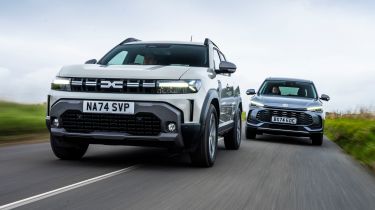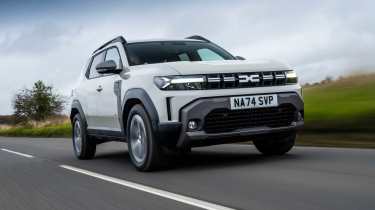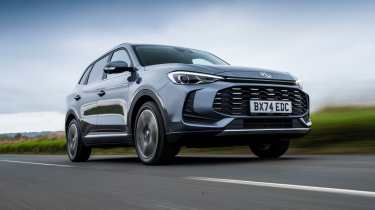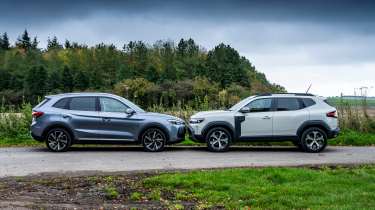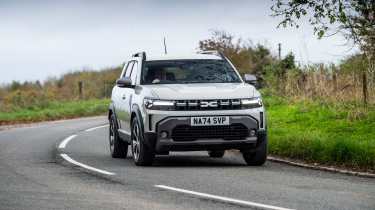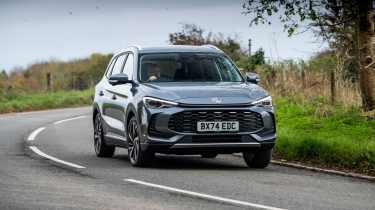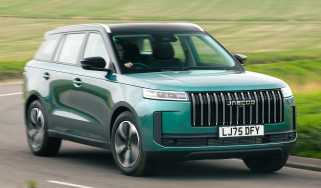Dacia Duster vs MG ZS: which is the best budget hybrid SUV?
The new Dacia Duster and MG ZS are the UK’s cheapest small SUVs. Which makes more sense in hybrid form?
“All the car you ever need” is something of a cliché, but at the same time it’s a phrase that raises a very pertinent question, given the current landscape of the UK market. Vast SUVs with six-figure price tags, and plug-in hybrids that struggle to deliver better efficiency than regular hybrids make you wonder if there’s a simpler way.
Well here’s a pair of new SUVs with hybrid assistance. Neither takes up much space on the road, nor will they make a big dent in your bank account. The first is from Dacia, a brand that has long stood for value for money, and while the latest Duster aims a little higher in terms of its social standing by displaying a more rugged, adventurous side, it’s still something of a bargain, with even the top-spec model weighing in at under £27,000.
Up against it is a brand with a familiar name that has waded into the same bargain-priced space that Dacia has occupied almost exclusively for years. The first MG ZS was a cheap family car that ticked many boxes, but its internal-combustion powertrain options were limited. Now MG hopes that a fresh model with a new hybrid powertrain will lift it fully into Dacia’s territory.
Dacia Duster
| Model: | Dacia Duster Hybrid Journey |
| Price: | £25,945 |
| Powertrain: | 4cyl, 1,598cc petrol engine, plus 2x e-motors, multi-mode auto, 138bhp |
| 0-62mph: | 10.1 seconds |
| Test efficiency: | 52.3mpg |
| Official range: | 575 miles |
| Annual VED: | £180 |
Dacia wants to pitch itself as an outdoorsy, lifestyle brand, and the Dacia Duster is the car in its line-up that fits that bill best of all.
Used - available now

2024 Nissan
Ariya
12,471 milesAutomaticElectric
Cash £25,490
2021 Lexus
UX 300e
39,392 milesAutomaticElectric
Cash £16,950
2023 Hyundai
i30
23,040 milesManualPetrol1.0L
Cash £14,801
2021 Vauxhall
Mokka
16,283 milesAutomaticPetrol1.2L
Cash £15,795The third generation of the small SUV has a more chunky look than its predecessor; it hasn’t just gained some brawn, but also some brains courtesy of a new hybrid powertrain and much-improved in-car tech, too. The Hybrid model kicks off from £24,245, but a base petrol/LPG version, badged Bi-Fuel, with a manual gearbox, is cheaper still, at £18,745.
Tester’s notes
The third-generation Duster has adopted a tough new look, with more thought being put into not only its overall shape, but many of the finer details, too. The squared-off bonnet edges give a distinctive appearance from behind the wheel, but also help the driver to place the front of the car in tight spots. Chunky plastic cladding surrounds the lower portions
of the car, too. The ZS looks sharper than before but, huge front grille aside, it doesn’t stand out from the crowd like the Duster.
MG ZS
| Model: | MG ZS Hybrid+ Trophy |
| Price: | £24,495 |
| Powertrain: | 4cyl, 1,498cc petrol engine, plus 1x e-motor, three-speed auto, 193bhp |
| 0-62mph: | 8.7 seconds |
| Test efficiency: | 48.7mpg |
| Official range: | 439 miles |
| Annual VED: | £180 |
Over the past few years, the MG ZS has represented a very affordable way into EV ownership, but this new model is offered exclusively with the same petrol-electric powertrain that we’ve already sampled in our 2024 Affordable Hybrid Car of the Year, the MG3.
As it stands, sales of the all-electric version of the ZS continue alongside the newcomer, but a refreshed design inside and out – not to mention more modern in-car tech – makes this new ZS feel like a big step forward in several ways.
Tester’s notes
Buyers have two trim levels to choose from: SE and Trophy. The former is the entry point into the range, and equipment levels are strong, with LED headlights, 17-inch alloy wheels, a 12.3-inch infotainment screen with a reversing camera and keyless entry – plus much more – as standard. The Trophy costs £2,500 extra and adds heated seats and steering wheel, a 360-degree parking camera, faux-leather upholstery, rear privacy glass plus 18-inch alloy wheels. Given the bargain pricing of both cars, we feel it’s worth stretching to the top-spec Trophy.
Head-to-head
On the road
In terms of performance, the MG takes a clear win in this contest, with excellent response around town in particular. The Dacia is more leisurely, a feeling reinforced by a fairly soft suspension set-up that promotes more relaxed driving. The Duster’s ride is also better and it feels secure on the road. Both cars have issues with refinement; for the Dacia it’s wind noise, while the MG’s vice is tyre roar at higher speeds.
Tech highlights
Hybrid power is the only option available to buyers of the new ZS from launch. It’s impressive on paper, though, both in terms of its 1.83kWh battery and the 134bhp produced by its e-motor. That latter number is almost as much as the 138bhp produced by the combined total of the Dacia’s electric and petrol sources. The Duster’s unusual clutchless gearbox takes inspiration from F1.
Price and running
Both cars return roughly 55mph on the WLTP cycle, but in the real world it’s the Dacia that proved more able to approach that figure, hitting 52.3mpg to the MG’s 48.7mpg. Both cars cost a similar amount with hybrid powertrains on board, but the MG has more standard kit and stronger performance. However, Duster buyers can save another £3,000 and choose the mild-hybrid petrol instead.
Practicality
There’s not much to separate this pair when it comes to interior or storage space – both are impressive. The Duster offers rear seat passengers a little more headroom, but the ZS has more generous kneeroom. Both have a similar boot volume, but non-hybrid Dusters offer more underfloor storage space and better cubby spaces in the cabin. The MG, however, has a lower boot lip for easier loading.
Safety
The likes of lane-change warning and a driver-fatigue warning system are fitted to the Duster as standard, with blind-spot warning available on Journey and Extreme trims, but even so, a three-star Euro NCAP rating is a bit disappointing Adaptive cruise control is standard on both MG ZS trim levels, as is blind-spot warning, lane-departure assist, and an active emergency braking system.
Ownership
Both cars are built to a price, but Dacia’s bean counters have chosen their battles better. MG has tried to give a veneer of poshness that has meant scrimping on some basics; there’s no reach-adjustment for the steering wheel and the fake leather feels slippery. The Dacia is more upfront about its penny pinching when it comes to hard plastics inside, but its ergonomics feel better considered.
Verdict
First place: Dacia Duster
Dacia might claim to be shuffling gradually away from its purely budget origins, but the Duster is still a bargain family SUV. However, it has more character than ever before; it looks unique, feels robust on the road, yet offers comfort that sets it apart from most rivals.
While the MG has it beaten for performance, everywhere else it’s much tighter; the Duster’s more honest, no-nonsense nature and desirability – not to mention its larger range of engines and trims with a lower starting price – are what seals its win here.
Second place: MG ZS
Against most other competition in this segment, the ZS would have had the talent to breeze to an easy victory – it’s only the Dacia’s all-round ability that confines the MG to second.
The MG is by no means a perfect car (we have questions over its fit and finish, the driving position, and the driveability of an otherwise very rapid powertrain), but those flaws are easier to forgive when you start to appreciate just what a strongly priced, well equipped and practical family SUV it is. It’s another big step in the right direction for MG.
Prices and specs
| Dacia Duster | MG ZS | |
| Our choice | Hybrid Journey | Hybrid+ Trophy |
| Price from/price of our choice | £18,745/£25,945 | £21,995/£24,495 |
| POWERTRAIN AND PERFORMANCE | ||
| Powertrain | 4cyl, 1,598cc, 2x e-motors | 4cyl, 1,498cc, 1 e-motor |
| Power | 138bhp | 193bhp |
| Torque | 205Nm | 343Nm |
| Transmission | Multi-mode auto/fwd | Three-speed auto/fwd |
| 0-62mph/top speed | 10.1 secs/105mph | 8.7 secs/115mph |
| Fuel tank | 50 litres/1.2kWh | 41 litres/1.83kWh |
| Test MPG | 52.3mpg | 48.7mpg |
| Test range | 575 miles | 439 miles |
| Charging | 114g/km | 115g/km |
| DIMENSIONS | ||
| Length/wheelbase | 4,343/2,657mm | 4,430/2,610mm |
| Width/height | 1,921/1,616mm | 1,818/1,635mm |
| Rear kneeroom | 605-735mm | 645-882mm |
| Rear headroom/ elbow room | 974/1,432mm | 954/1,435mm |
| Boot space (frunk/ seats up/down) | 430/1,545 litres | 443/1,457 litres |
| Boot length/width | 870/1,005mm | 874/1,005mm |
| Boot lip height | 805mm | 704mm |
| Kerbweight/ towing weight | 1,455/750kg | 1,420/500kg |
| Turning circle | 10.9 metres | 10.5 metres |
| COSTS/OWNERSHIP | ||
| Residuals (3yrs/36k miles) | £14,794/57.0% | £12,424/50.7% |
| Depreciation | £11,151 | £9,571 |
| Insurance group/quote/VED | 24/£503/£180 | 22/£571/£180 |
| Three-year service cost | £468 | £729 (est) |
| Annual tax liability std/higher rate | £1,295/£2,590 | £1,357/£2,714 |
| Annual fuel cost (10k miles) | £1,220 | £1,310 |
| Basic warranty (miles)/recovery | 3yrs (60,000)/3yrs | 7yrs (80,000)/1yr |
| Driver Power manufacturer position | 22nd/32 | 32nd/32 |
| Euro NCAP Adult/child/ped./assist/stars | 70/84/60/57/3 (2024) | N/A |
| EQUIPMENT | ||
| Metallic paint/wheel size | £650/17 inches | £545/18 inches |
| Parking sensors/reversing camera | F&r/yes | F&r/360 |
| Spare wheel/Isofix points | £300/two | Repair kit/two |
| Keyless entry & go/powered tailgate | Yes/no | Yes/yes |
| Leather trim/heated seats | No/no | Faux/yes |
| Screen size/digital dashboard | 10.1 inches/yes | 12.3 inches/yes |
| Climate control/panoramic sunroof | Yes/no | Yes/yes |
| USB count/wireless charging | Four/yes | Three/yes |
| Wireless CarPlay/Android Auto | Yes/yes | Yes/yes |
| Blind-spot warning/head-up display | Yes/no | Yes/no |
| Adaptive cruise control/steering assist | No/yes | Yes/yes |
What we would choose
Dacia Duster
There’s a wide range of accessories. Beyond those clever Youclip add-ons, there’s also a set of roof bars, plus you can purchase a tent that attaches to the open tailgate, transforming the cabin into a roomy campsite.
MG ZS
The scope for customisation is very narrow for ZS buyers, with choices limited to the two trim levels and the six exterior paint colour options. Battersea Blue and Dynamic Red are the most eye-catching choices.

